St. Anton am Arlberg is a charming Tyrolean village where people from around the world come to ski hard and party harder. Thanks to its location high in the Arlberg massif, the snow keeps falling in St. Anton late into the ski season. Visitors to St. Anton can enjoy premier Alpine skiing, sun-soaked terraces at high altitudes, and some of Europe’s favourite après-ski, all while other resorts in the Alps are green with envy. Alyssa James tells TravelMag about her late-season skiing experience in the Austrian Tyrol.
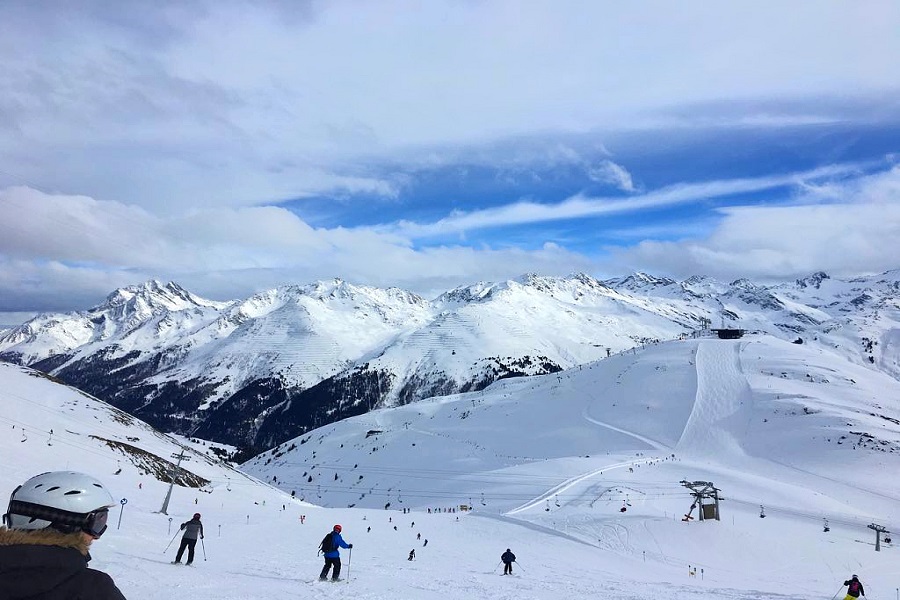
Snow continues falling until late April in St. Anton (Photo: Thomas Dub)
Stepping out of the train station and onto dry land was both exciting and disconcerting. Since my previous ski trips in the French Alps were marked by icy roads and snow crunching beneath my feet, the easy journey from Zurich to the centre of St. Anton and being greeted by sunshine felt wrong. The village of St. Anton lies at 1,304 m above sea level; by mid-March, snowflakes disappear into the asphalt almost as quickly as they fall. I would learn later that up here in the Arlberg there is little correlation between the snow in the village and the snow on the slopes.
A jaunt along the pedestrianized Dorfstraße, the town’s main street, takes you from the main gondolas past locally-owned shops, hotels, restaurants, and bars. Despite the substantial number of visitors from around the world, this cozy little town of 2,470 retains much of its local character. Several of the hotels and shops are still housed in original timber and stone farmhouses, while Baroque frescoes represent St. Anton’s regional heritage.
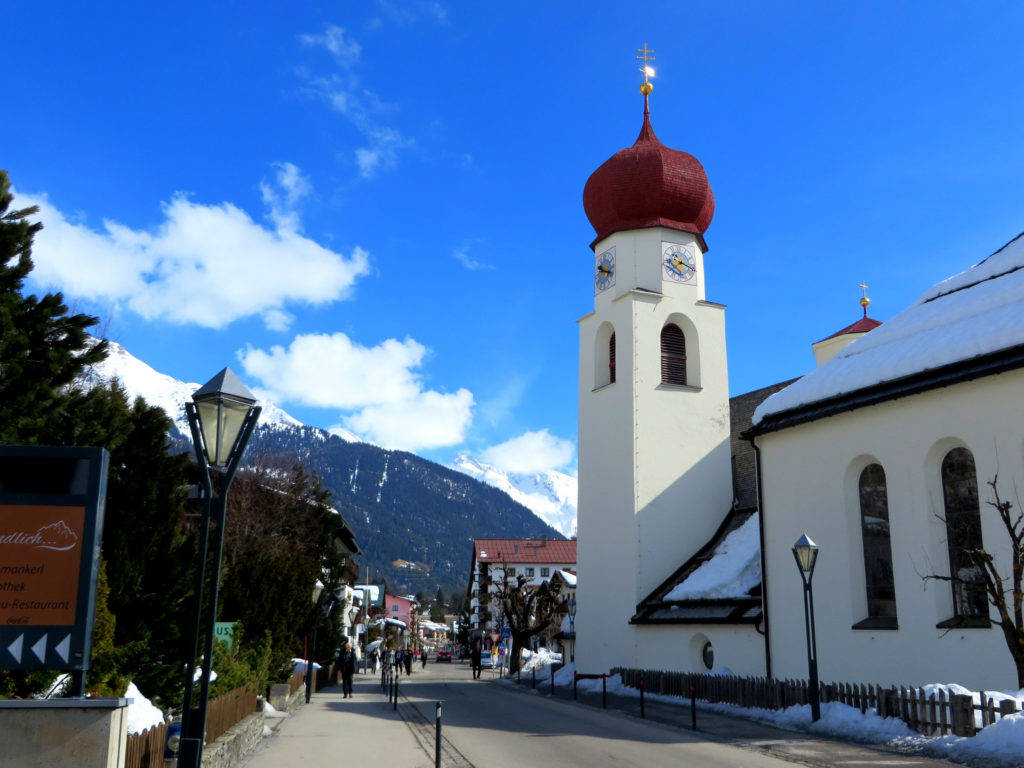
The St. Anton parish church on Dorfstraße was consecrated in 1698 (Photo: Alyssa James)
Heritage and tradition loom large in St. Anton, particularly when it comes to winter sports. In the winter of 1895, the parish priest of Lech made his first attempt at skiing; by 1901, a group of friends formed the Arlberg Ski Club, among the first in the Alps. Today, this resort boasts 305 kilometres of groomed slopes and 88 lifts, including the revolutionary Ferris wheel-style Galzigbahn. A visit to the St. Anton Museum (Rudi-Matt-Weg 10) allows you to explore the evolution of skiing in the region, but all you need do is open your eyes. From old wooden skis hung in hotel lobbies and vintage two-seaters in Stuben, to the high-speed chairlifts with heated seats, the proof is in the place.
With 200 kilometres of fierce off-piste terrain and exhilarating descents, St. Anton is aimed at the advanced skier or a strong intermediate who is ready to move from pistes to powder. Cable cars ascend to Valluga (2,811 m), the trophy off-piste area that offers incredible views from the peak all the way down to Lech Zürs am Arlberg.
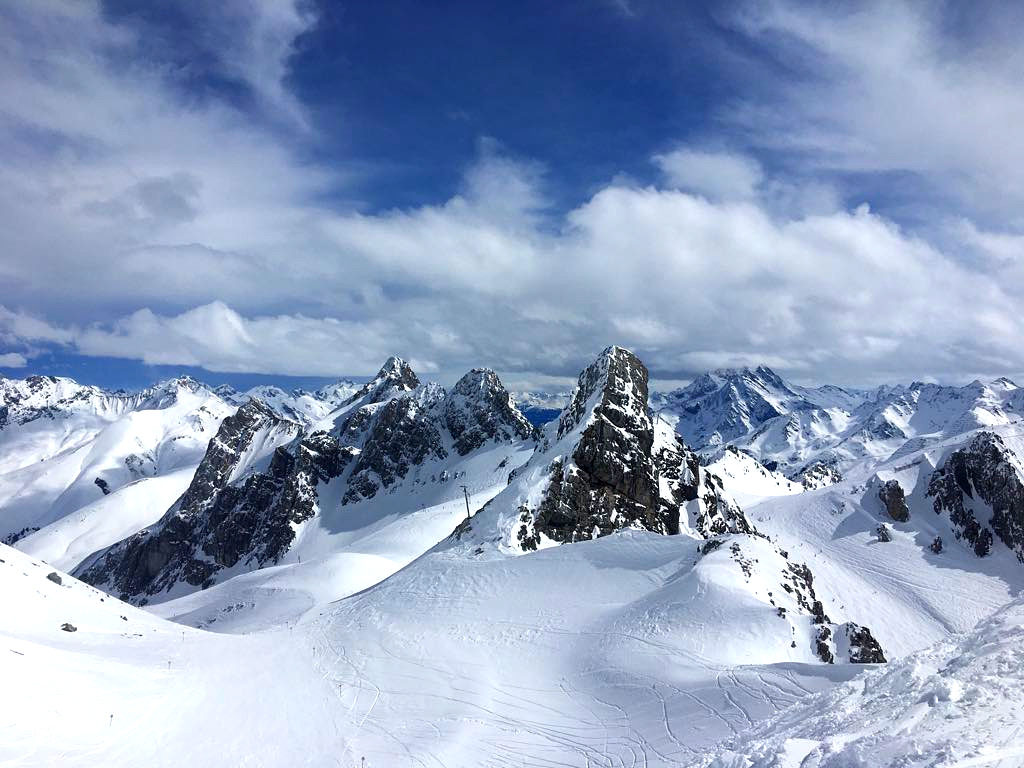
Access fresh powder around the Arlberg with one lift pass (Photo: Thomas Dub)
However, with only four days of ski experience under my belt, my first afternoon on the slopes was a blow to my confidence. There are nursery slopes at Nasserein, but I went straight up to Rendl (2,030 m) on the recommendation of a seasonnaire at a ski hire shop. The pitch of the slopes makes St. Anton a challenging place to learn, especially for nervous or tentative skiers. Beginners need some fearlessness to progress quickly and make the most of their visit. There are no green runs and even the so-called ‘gentle blues’ can be steeper and bumpier than blues at other resorts. Once you get the hang of it, there are plenty of blue runs from St. Anton, St. Christoph, Stuben, Lech, and back.

The views from Rendl (Photo: Alyssa James)
If you don’t take to the slopes, St. Anton offers plenty of non-skiing and snowboarding activities, too. On Tuesdays and Thursdays, the four-kilometre toboggan run from Gampen to Nasserein opens up in the evening for après-ski excitement. Participants either race down or make pit stops at some of the restaurants and bars on the way, including the Rodelalm, the popular restaurant and après-ski bar, which stays open late for the event.
The area around St. Anton also has 70 kilometres of hiking paths for winter walking or snowshoeing, as well as paragliding, swimming, spas, and of course, the famous après-ski. Thanks to the central Intercity and Railjet station – a rare feature at major ski resorts – getting out of St. Anton for a day is easy. Hop on the train to Innsbruck, the capital of Tyrol, and explore the Gothic churches and imperial palaces of the historic town. Alternatively, it’s a short trip to the medieval city of Feldkirch. The 800-year old city is visually striking, but it’s the Schattenburg Castle (Burggasse 1) restaurant that gets much of the glory: visitors come from all over to eat schnitzel that is fit for a king. At 30 centimetres in diameter, the escalope barely fits on your plate, much less your stomach!
Hotels
The hotels in St. Anton range from contemporary hotels to typical Tyrolean pensions and family-run chalets. Many of the hotels in St. Anton include half-board – breakfast and dinner each day during your stay – but the common Alpine ski-in/ski-out set-up is a rarity. To compensate, many hotels have storage arrangements with ski hire shops next to the Galzigbahn so you can avoid trudging down Dorfstraße in your ski boots.
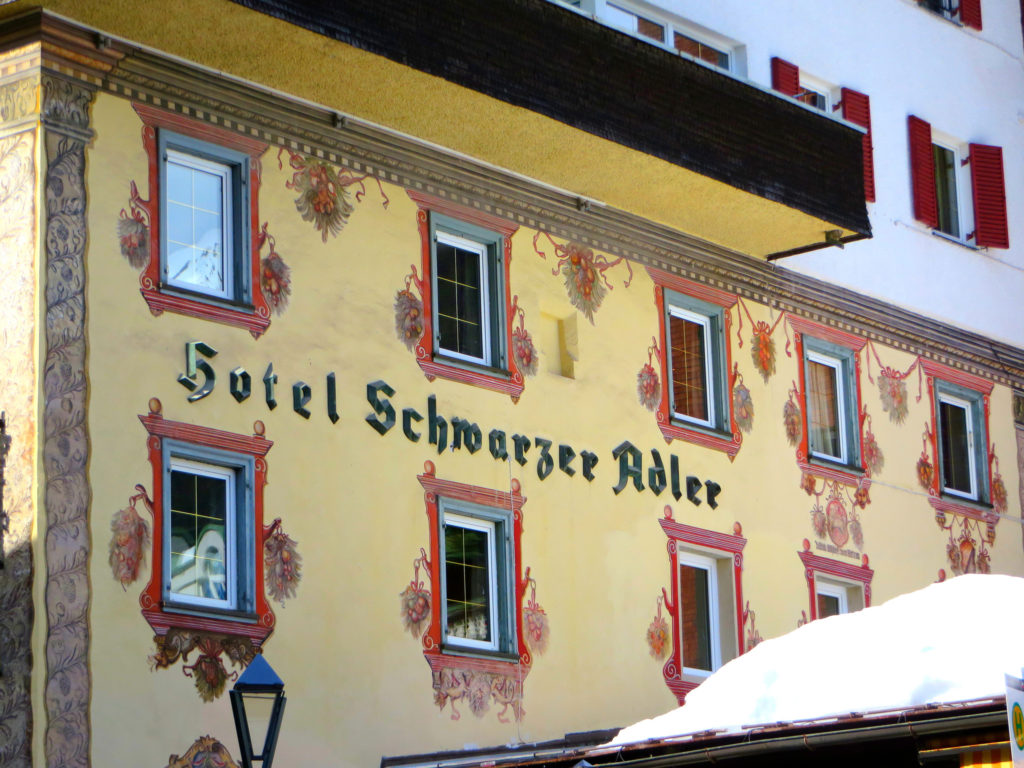
The Schwarzer Adler’s frescoes recall of Austria’s art heritage (Photo: Alyssa James)
The 4-star Hotel Schwarzer Adler (Dorfstraße 35) offers typical Tyrolean character and hospitality interpreted in a modern way. The hotel has been owned by the same family since 1885, but the building itself is more than 400 years old. The rooms have a distinctly alpine feel with pine walls, simple wood furnishings, and cozy bedding. However, it’s the small touches that make the Schwarzer Adler a stand-out. The luxury spa with indoor pool, saunas, relaxation room, and rooftop Skypool with a gorgeous view of the mountains in the distance, is a lovely place to unwind after a day on the slopes. It’s also available to guests until 6 PM the day of check-out, which is ideal for getting that 7th day of skiing done. Stays include spa access, buffet breakfast, afternoon tea, and five-course dinners.
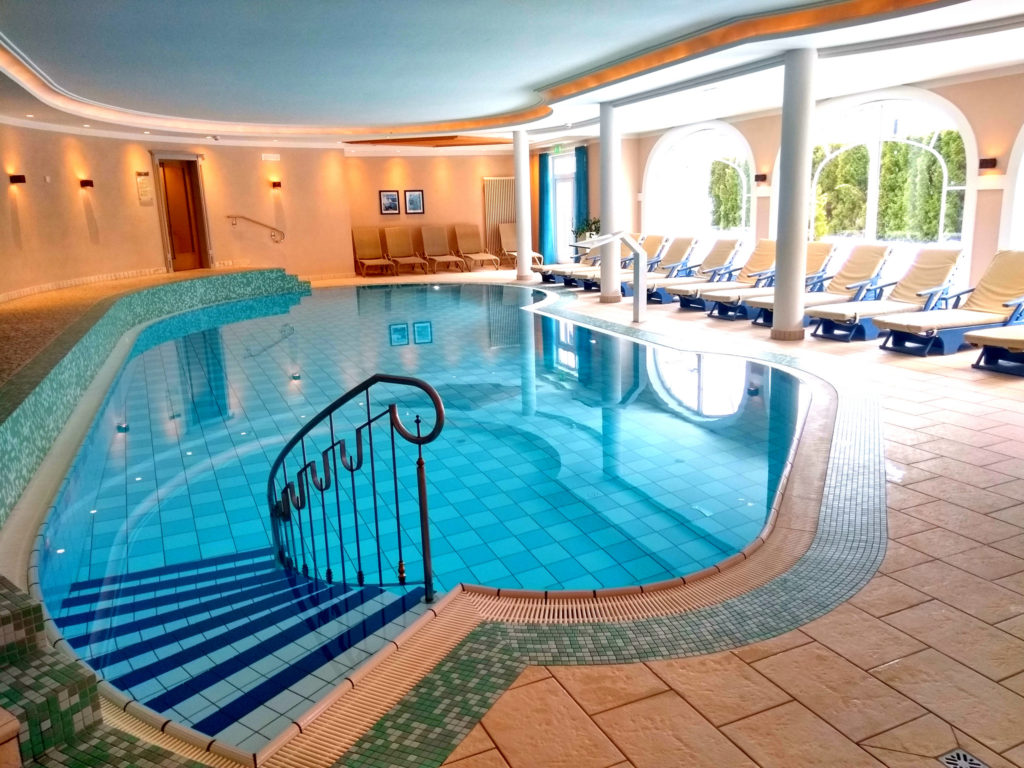
Indoor swimming pool at the Schwarzer Adler (Photo: Alyssa James)
The Hotel Post (Walter-Schuler-Weg 2) is located at the centre of the pedestrian area, ideally located for the bars, nightclubs, and main gondolas. The hotel packs some serious ski heritage. Johann Schneider, considered the father of modern skiing, was a guide here in 1907. It was during this time he developed what came to be known as the Arlberg technique. The family-friendly Hotel Post features rustic décor with dark oak finishes and grand chandeliers in the dining room. The hotel offers a breakfast buffet, evening menu, and a weekly five-course gala dinner. The Relax Center is the gem of the hotel, featuring a indoor pool with waterfall and jets, salt water and aroma steam baths, as well as a solarium.
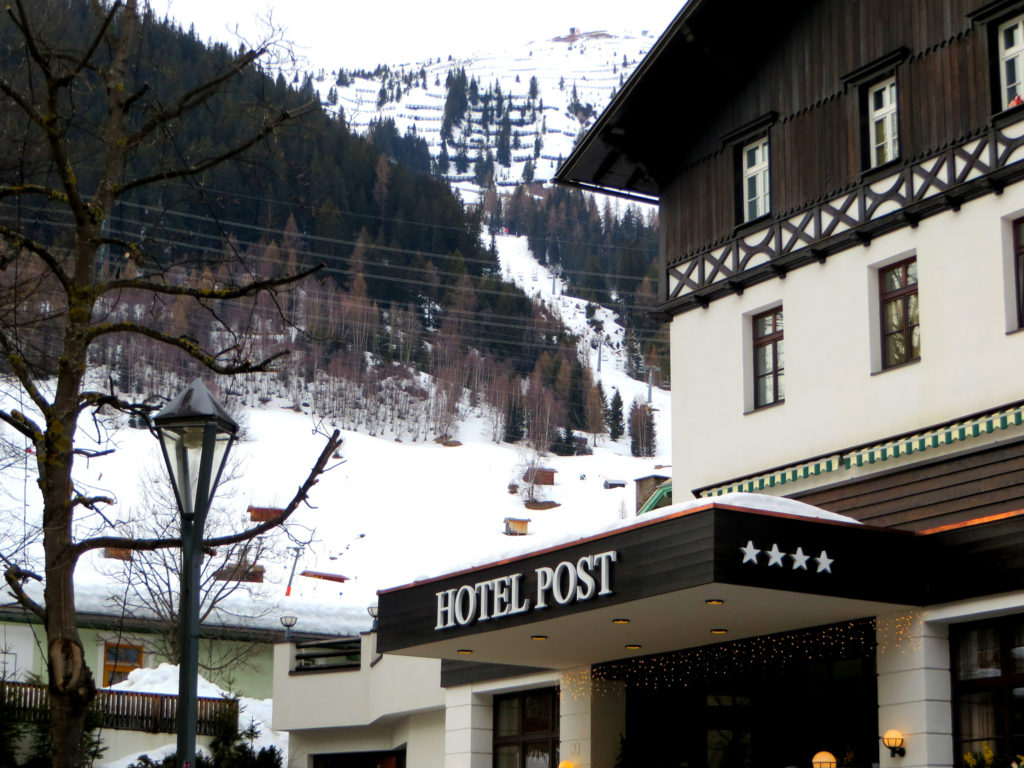
The Hotel Post is rustic Tyrolean charm (Photo: Alyssa James)
Skihotel Galzig (Hannes-Schneider-Weg 5) is one of the rare ski-in/ski-out hotels located at the base of the Galzig and Rendl gondolas. Rooms here are sophisticated and minimalist, offering that upscale ultra-modern feel in the heart of St. Anton. Breakfast is included in all stays and one of the best restaurants in the village, the Galzig Bistro Bar (Kandaharweg 2) is just next door. With early check-in and late check-out, Skihotel Galzig is perfect for visitors who want to keep the fun going long after the slopes have closed for the night.
Restaurants & Bars
St. Anton is the place where the famous and infamous love to ski and play. As a premier ski resort, there is no shortage of Michelin-star restaurants, but that doesn’t mean you have to expect five-star prices. There are plenty of excellent restaurants where you can enjoy traditional Austrian ski lunches and schnapps on the slopes.
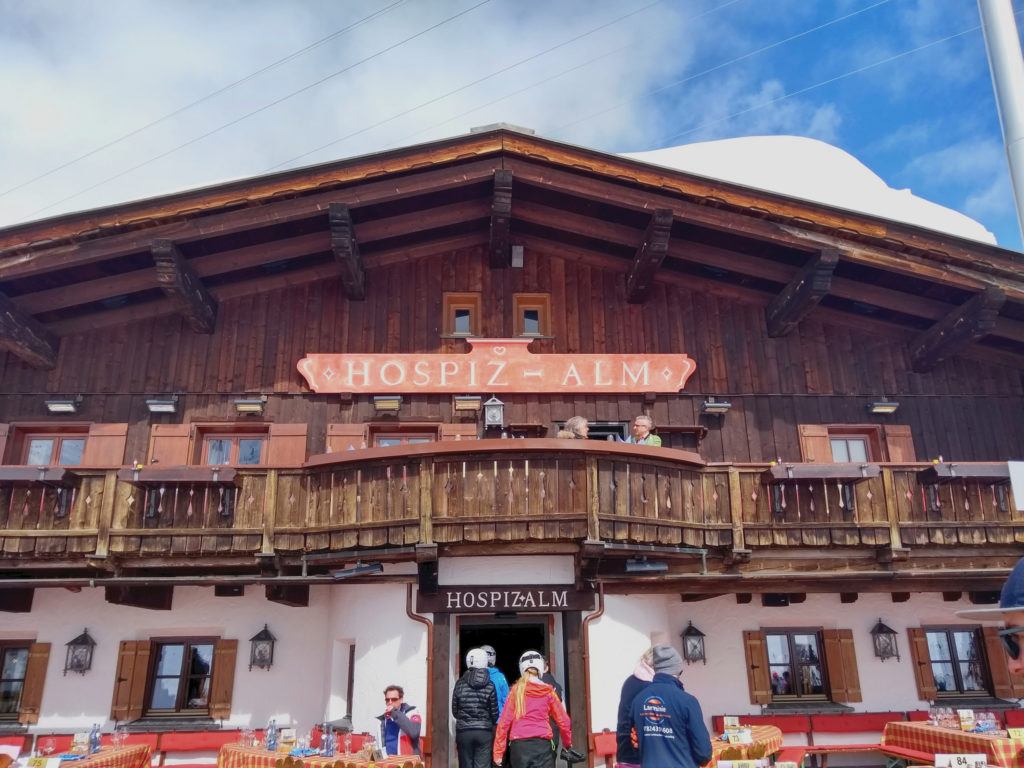
Sun terrace of the Hospiz Alm in St. Christoph (Photo: Alyssa James)
Swing over to St. Christoph for lunch around a roaring fire at the Hospiz Alm (St. Christoph 18) at the base of the St. Christoph chairlift. The Arlberg Hospiz Hotel (St. Christoph 1) is one of the oldest in the Alps, introduced as an inn for travellers crossing the Arlberg Pass in the 1300s. Today, it’s an exclusive 5-star hotel that runs this famous restaurants that has seen guests like the King of Spain as well as Prince Charles and Lady Diana. The restaurant’s sun terrace overlooks the piste and the rest of the village. The menu is extensive, as is the wine list; its famous wine cellar (accessed by a slide to avoid the precarious walk down the stairs in ski boots) is said to house several million euros-worth of wine. Warm up next to the fire in the wood and stone hut with a hearty Tyroler gröstl or a typical kaiserschmarrn. Be sure to make a reservation or the only warming you’ll get will be with a (tasty) rum and hot chocolate by the bar!
The Rendl Restaurant is right next to the Rendl gondola and offers a large sun terrace overlooking the Riffelscharte valley and the snowboard stunt park. Grab a lounge chair and order a burger and chips or freshly prepared wok dish to refuel for the afternoon skiing.
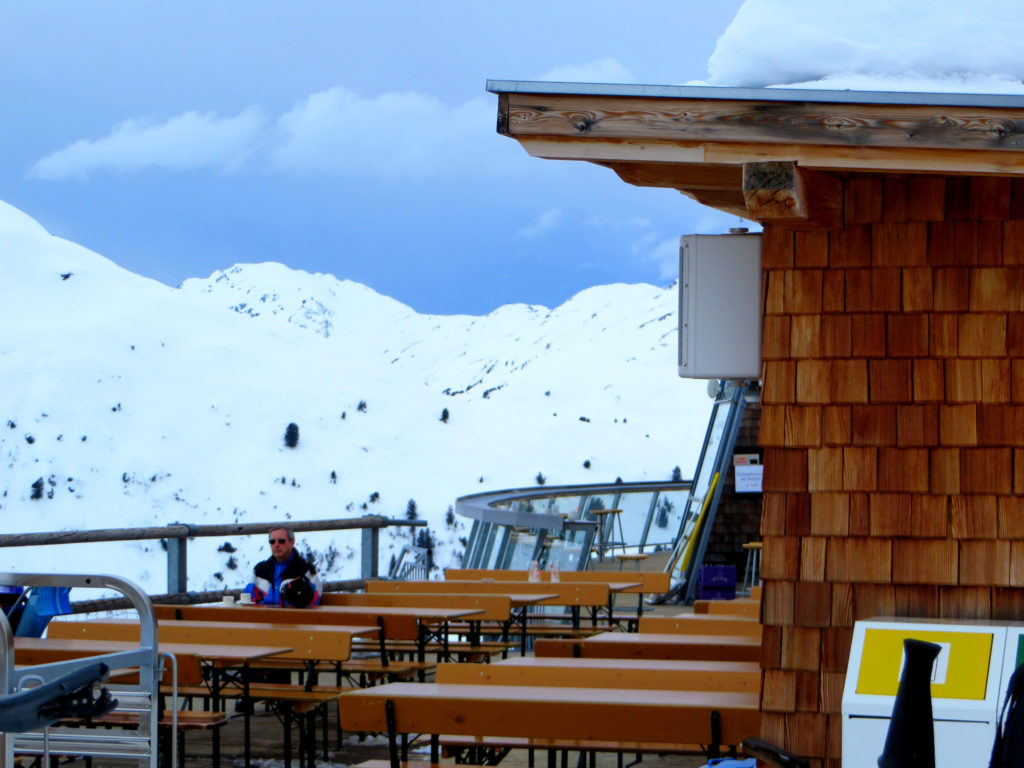
View from the restaurant next to the Rendl gondola (Photo: Alyssa James)
Alber’s Rodelalm and Robi’s Rodelstall are the rustic mountain huts on the toboggan run that serve local classics. People stop at the Alm for lunch to enjoy the sun terrace and schnapps. The Stall is popular on Tuesdays and Thursdays when the restaurants stay open late for sledders careering down the Rodelbahn looking for Schweinshaxe (pork knuckles) and fondue. You might want to have a go at the famous Nail Game; though after a few beers, it might be best to avoid playing with a hammer, nail, and a block of wood.
The Albona Mittelstation at the top of the Albona I cable car in Stuben is a self-service restaurant that works well as a quick stop before continuing your adventure. Large portions of Austro-German favourites like germknödel (a steamed dumpling filled with plum jam, doused in vanilla sauce), currywurst and chips, and apple strudel will fill you up without emptying your pockets.
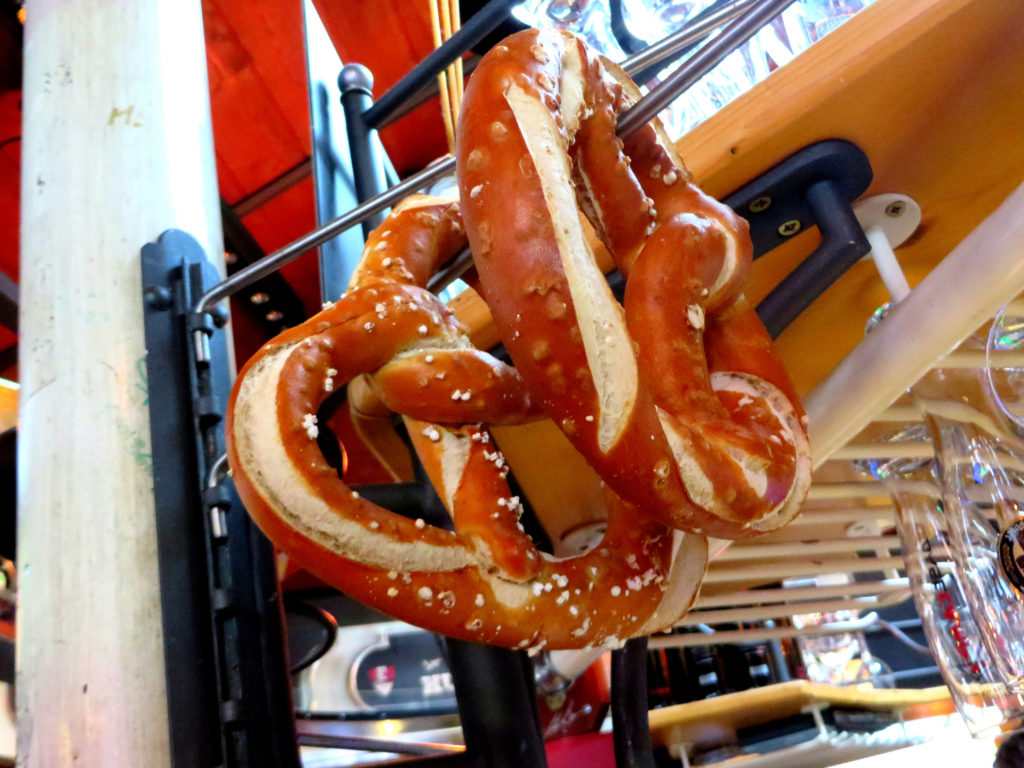
Hanging pretzels as an apres-ski snack (Photo: Alyssa James)
At 400 years old, the Tyrolean dining parlour is one of the oldest parts of the Hotel Schwarzer Adler. You’ll be offered modern takes on traditional Austrian cuisine served up by attentive waitstaff and complemented by wonderful wines. Chef Stephan Dialer prepares food with local products in delightfully surprising ways, from foam of zucchini soup, perfectly roasted venison, to a marinated scallop amuse-bouche.
In St. Anton, people party as hard as they ski, making the resort a favourite for its high-altitude fun. Afternoons and evenings are filled with pear schnapps, Jägermeister, Europop singalongs, and dancing in ski boots. If St. Anton is the kingdom of après-ski, then Mooserwirt (Unterer Mooserweg 2) is the palace. The bar calls itself ‘probably the worst ski hut on the Arlberg,’ but that doesn’t stop hundreds from skiing in on their way home for dancing and beer.
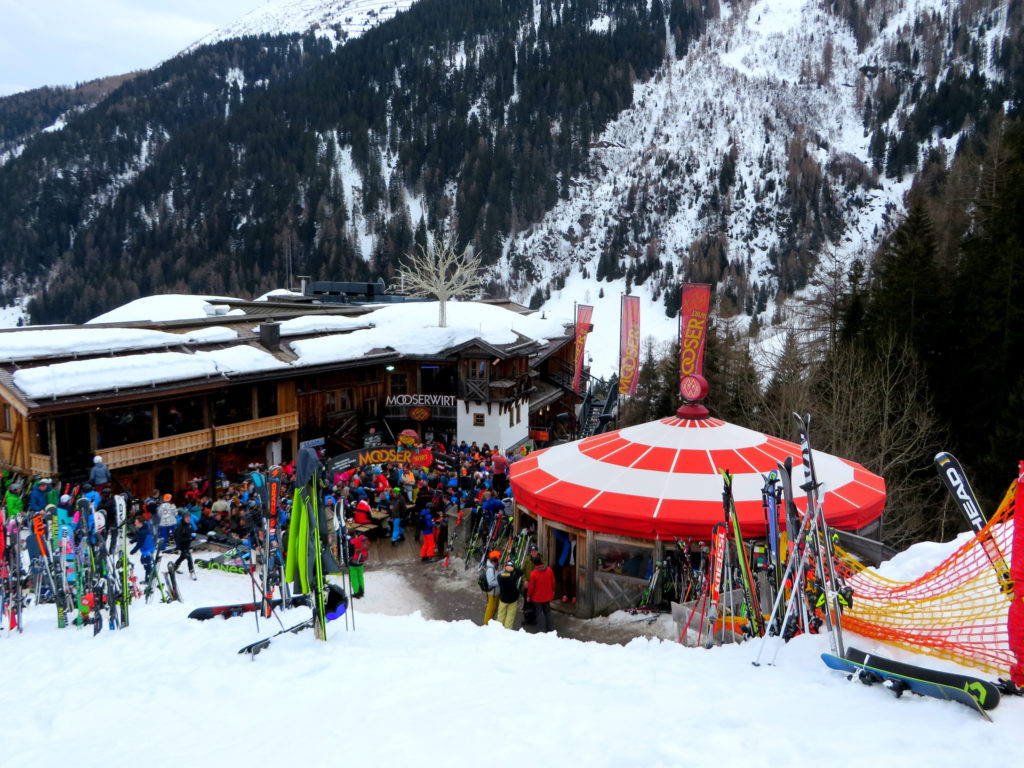
Mooserwirt is an apres-ski favourite on the final run home (Photo: Alyssa James)
Other après-ski bars on the mountains people love include Krazy Kanguruh (Mooserweg 19), which really gets crazy, and Heustadl (Dengertstraße 625), beloved for the nightly live music. People who are already in town – or who don’t want to ski home in the dark – head to Basecamp (Kandaharweg 13), just at the foot of the Galzigbahn, where there is live music and a covered outdoor bar area. The bars cool down until after dinner, when part two of the après-ski kicks off in town. Hordes of people walk the main drag of Dorfstraße heading to dance at Postkeller (Walter-Schuler-Weg 2) or take down steins of beer at Piccadilly (Dorfstraße 19), the British live music bar in the centre.
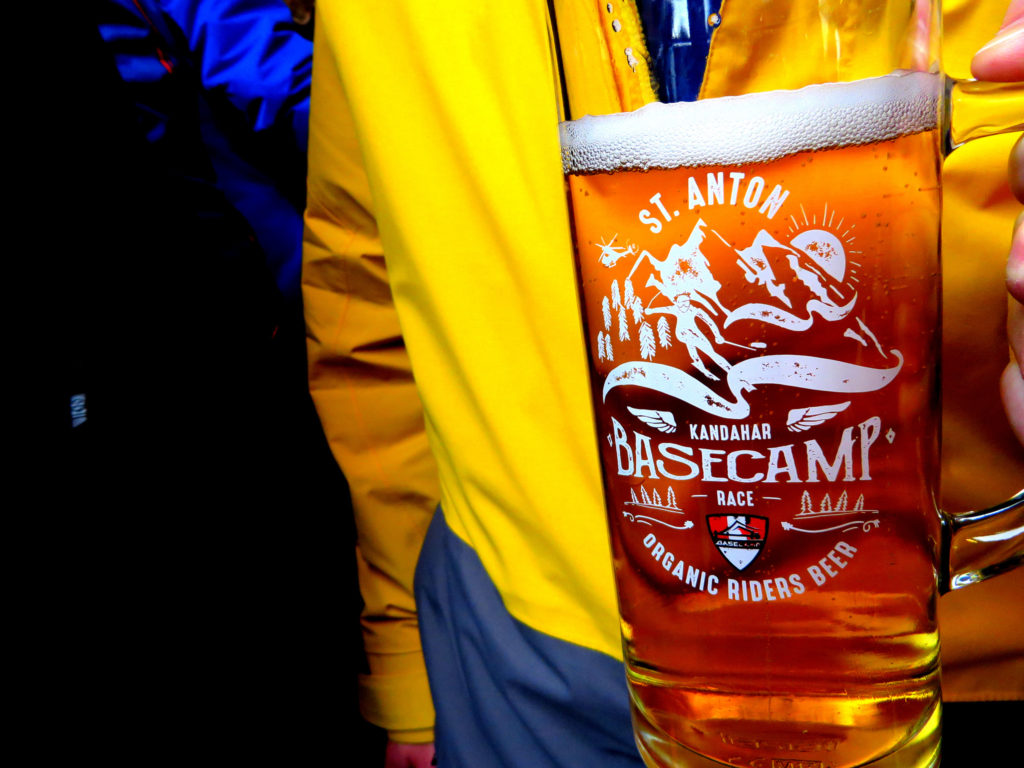
Ski boots and beers at Basecamp (Photo: Alyssa James)
The writer travelled to St. Anton with support from the St. Anton Tourism Association (stantonamarlberg.com) and the Hotel Schwarzer Adler (schwarzeradler.com). Neither the tourism association nor the hotel reviewed or approved this article before publication.